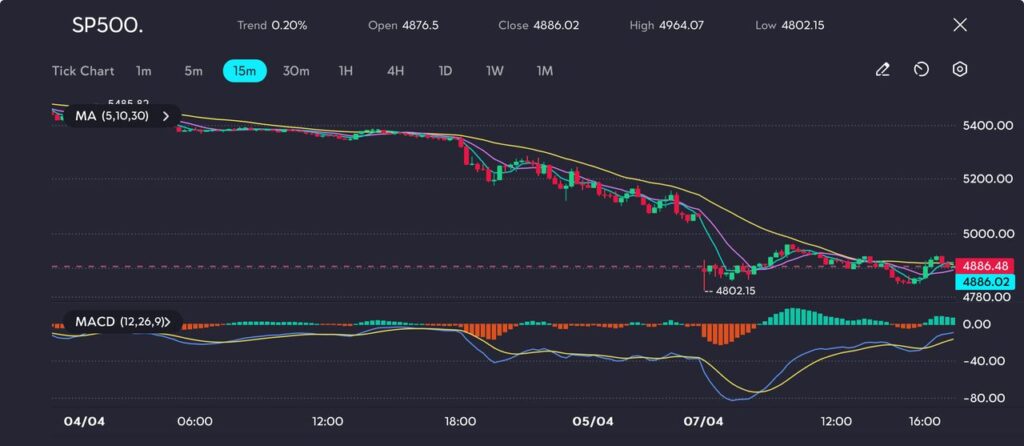
The US stock market is under intense pressure as investor confidence takes a hit from worsening global trade tensions and fears of an economic slowdown. Uncertainty around future policy moves and a sharp shift in sentiment have triggered a broad sell-off, with traders pulling back from riskier assets and turning to safer options. This environment of heightened volatility is challenging even experienced market participants, as the outlook grows increasingly fragile.
The US stock market is experiencing its most turbulent week in recent years, as mounting trade disputes and global economic uncertainty prompt investors to abandon equities in favour of safer assets.
As of 9:42 AM GMT, S&P 500 E-mini futures dropped 159 points (-3.11%), extending a two-day plunge that has shaved 10.5% off the index, wiping nearly USD 5 trillion in market value.
The benchmark has now declined over 20% from its record highs, confirming its entry into bear market territory—the first since the COVID-19 crash in March 2020.
Tensions escalated after President Donald Trump reaffirmed his stance on maintaining tariffs and delaying negotiations with China, insisting that trade imbalances must be addressed first.
Markets have taken this as a sign that the trade war could be prolonged, fuelling fears of deeper economic disruption.
Nasdaq 100 futures slumped 598.5 points (-3.41%), and Dow futures fell 1,178 points (-3.06%), signalling broad-based selling.
The Nasdaq Composite has officially entered a bear market, weighed down by a steep decline in tech stocks, while the Dow Jones Industrial Average has retreated over 10% from recent peaks.
Investors are flocking to safe-haven instruments as risk appetite deteriorates.
The 10-year US Treasury yield has fallen to 3.953%, slipping beneath the critical 4% psychological threshold, as demand for government bonds accelerates. This sharp drop underscores growing recession fears.
Market participants now estimate a 54% chance of a fifth Federal Reserve rate cut this year, suggesting that further monetary easing could be on the cards to cushion the impact of trade headwinds.
The CBOE Volatility Index (VIX)—often dubbed the Wall Street fear gauge—soared 7.57 points to 52.88, its highest reading since the early COVID-19 shock. This heightened volatility reflects deepening market unease and ongoing uncertainty.
Short-term technical indicators paint a grim picture for the S&P 500 (SP500).
A 15-minute candlestick chart shows the index sliding from 4,964.07 to a low of 4,802.15, before recovering slightly to close at 4,886.02.
Bearish alignment across the 5, 10, and 30-period moving averages points to persistent selling momentum.

The MACD (12,26,9) signals a potential shift, with the histogram turning green after extended lows—an early indication of possible technical relief. However, there’s no definitive sign of a trend reversal.
The index may be poised for a short-term rebound, but downside risk remains elevated. A decisive move below the 4,800 support level could pave the way for a rapid test of February’s lows.
With uncertainty high and Washington maintaining a tough trade stance, markets are likely to remain volatile.
While the prospect of further rate cuts could provide temporary support, investor sentiment remains on edge.
Any rebound in equities might turn out to be a bear market trap if macroeconomic data—such as Thursday’s consumer price report—fails to signal a meaningful shift in inflation dynamics.
In the near term, a defensive investment approach is advisable. Expect continued flows into bonds and traditional safe-haven sectors, as equities may remain under pressure until there’s clearer policy guidance or economic improvement.
Click here to open account and start trading.